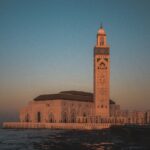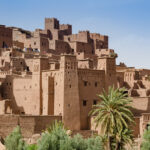Exploring the Top Historic Sites and Monuments in Marrakech
Marrakech, known as the “Red City” for its pink-hued buildings and architecture, has a rich cultural heritage spanning over ten centuries. As the imperial capital of multiple Moroccan dynasties and an important trading center along historic caravan routes, Marrakech became filled with magnificent palaces, mosques, madrassas (theological colleges), and gardens that still stand today as iconic monuments.
For visitors interested in history, architecture, and Moroccan tradition, several key historic sites should be top priorities to explore while in Marrakech. This includes the grand Bahia Palace, ruins of El Badi Palace, theological college Ben Youssef Madrassa, and contemporary botanical haven Majorelle Garden.
The Opulent Bahia Palace: Grand Residence of 19th Century Viziers
Built in the late 19th century, the Bahia Palace was intended by Grand Vizier Si Moussa as his grand palace, using the finest artisans at the time to construct a residence meant to be the greatest of its time in Marrakech. The sprawling palace complex took many years and multiple additions by later inhabitants like Bou Ahmed to complete. Today, it stands remarkably preserved as one of the most prominent historic attractions in Marrakech.
Key Highlights of Bahia Palace:
- Grand Central Courtyard: Main courtyard boasting traditional Moroccan and Andalusian design. Surrounded by detailed carved stucco and painted wooden ceilings.
- Quarters for 4 Wives: Si Moussa kept four wives in accordance with Islamic law. Each wife had her own spacious living quarter.
- Concubine Chambers: In addition to the wives, concubines also stayed on the palace grounds in more discrete but lavishly decorated chambers.
- Grand Riad Garden: A rare integration of green space, fountains, and small reflecting ponds throughout the residence.
Visitors today can take guided tours through the well-preserved interior rooms, hallways, and gardens of this 19th century palace. With so much intricate tilework, carvings, and artifacts intact within the palace, tourists gain great insight into the opulent lifestyle of high Moroccan dignitaries during this imperial era. Those wishing to walk in the footsteps of viziers and court figures will be awed by the Bahia Palace.
Ruins & Legends: Exploring 16th Century El Badi Palace Site
Prior to Bahia Palace, one of the preeminent palaces built in Marrakech was commissioned by the Saadian Sultan Ahmad al-Mansur in 1578 CE, named El Badi or “the incomparable.” Constructed to showcase opulence through its 360 rooms, lavish entertainments, and festivals, little remains today outside of monumental ruins. Nonetheless, the remarkable craftsmanship evidenced in intricate indoor stonework, grand arches, and sprawling layout gives modern visitors a glimpse into the grandeur and excess that defined the lifestyle of 16th century sultans.
While legends swirl about how quickly El Badi Palace deteriorated over the subsequent centuries after al-Mansur’s death, the lingering remnants still transport one back to this dynamic era in Marrakech’s past. Visitors can climb ramparts to gaze out at a tableau view of the city much like royal residents once did. As an iconic site for events, its impressive presence seemingly still inspires modern festivals echoing aspects of grand celebrations once held here centuries ago.
Ben Youssef Madrassa: Insight into Historic Education in the Medina
As the largest theological college or madrassa in all of Morocco, the Ben Youssef Madrassa just north of Marrakech’s central medina offers great insight into historic education and 14th century architecture. Founded during the Marinid dynasty which reigned from the 13th to 15th centuries, scholars estimate it could accommodate up to 900 students in its heyday. Comprised of plain exterior walls, the interior contains splendid carved cedar, stucco walls with Islamic motifs, and Arabic calligraphy lining walls around its tranquil central courtyard.
Adjacent to the larger Ben Youssef mosque, the madrassa gives visitors a feel for learning environments that trained Islamic scholars and officials. Guides can detail more on subjects of study, student life, and the overall legacy these madrassas had in spreading religion, law, philosophy and culture throughout North African communities and regions like Marrakech for centuries.
Art Deco Gardens & Avant-Garde Style at Majorelle
Beyond imperial era sites, the Majorelle Garden stands out as a more contemporary early 20th century fixture that continues to be one of Marrakech’s top attractions. Designed by French painter Jacques Majorelle over forty years starting in 1924, these lush botanical gardens surround his electric blue Cubist villa home and bright yellow studio. With a bold Art Deco aesthetic, much of the architecture and garden layout still follows Majorelle’s avant-garde vision from that era.
Later restored and opened to visitors by fashion icons Yves Saint Laurent and Pierre Bergé in the 1980s, Majorelle Garden remains a tranquil, stylish oasis located just outside the medina’s walls. Visitors admire not only diverse plant species and fountains but also many Art Deco architectural details found nowhere else in Marrakech. For a glimpse of how European aesthetics interfaced with Berber craftsmanship, a stroll through these lush gardens makes for a perfect counterbalance after exploring the medina.
Essential Tips for Visiting Marrakech’s Historic Sites
Getting Around: Many options exist for getting between sites efficiently, especially if staying outside the medina itself:
- Hire a private tour guide in Marrakech for customized historic tours
- Use petit taxi transfers to/from Marrakech airport for major sites outside the medina
- Have hotel arrange shuttle or porter to navigate twisting medina alleyways
Beat the Crowds: Morning and late afternoon tend to be less crowded times for exploring major monuments and museums.
Beat the Heat: Spring, fall and winter months offer more moderate temperatures for extended walking between historic attractions in Marrakech. Time indoor visits during hottest mid-day times.
See It All: Consider multi-day Marrakech guided tour packages that hit all major sites along with day trips to nearby Atlas Mountain villages and terrain for those short on time.
Stay Nearby: Overnight in one of the small restored riads converted into hotels just adjacent to Bahia Palace, El Badi and Ben Youssef Madrassa to visit early before crowds and heat arrive.
With 10+ centuries of various dynasties calling Marrakech home, the city remains remarkably well-preserved in key monuments that exemplify North African architecture, artistry and culture as it evolved over time. As one of Morocco’s top destinations, no visit is complete without spending time at these standout historic sites – Bahia Palace, El Badi ruins, Ben Youssech Madrassa complex or the distinctive Majorelle Garden.


